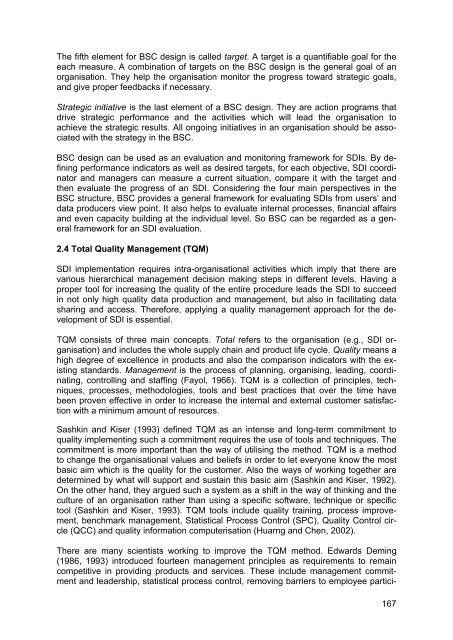SDI Convergence - Nederlandse Commissie voor Geodesie - KNAW
SDI Convergence - Nederlandse Commissie voor Geodesie - KNAW
SDI Convergence - Nederlandse Commissie voor Geodesie - KNAW
Create successful ePaper yourself
Turn your PDF publications into a flip-book with our unique Google optimized e-Paper software.
The fifth element for BSC design is called target. A target is a quantifiable goal for the<br />
each measure. A combination of targets on the BSC design is the general goal of an<br />
organisation. They help the organisation monitor the progress toward strategic goals,<br />
and give proper feedbacks if necessary.<br />
Strategic initiative is the last element of a BSC design. They are action programs that<br />
drive strategic performance and the activities which will lead the organisation to<br />
achieve the strategic results. All ongoing initiatives in an organisation should be associated<br />
with the strategy in the BSC.<br />
BSC design can be used as an evaluation and monitoring framework for <strong>SDI</strong>s. By defining<br />
performance indicators as well as desired targets, for each objective, <strong>SDI</strong> coordinator<br />
and managers can measure a current situation, compare it with the target and<br />
then evaluate the progress of an <strong>SDI</strong>. Considering the four main perspectives in the<br />
BSC structure, BSC provides a general framework for evaluating <strong>SDI</strong>s from users’ and<br />
data producers view point. It also helps to evaluate internal processes, financial affairs<br />
and even capacity building at the individual level. So BSC can be regarded as a general<br />
framework for an <strong>SDI</strong> evaluation.<br />
2.4 Total Quality Management (TQM)<br />
<strong>SDI</strong> implementation requires intra-organisational activities which imply that there are<br />
various hierarchical management decision making steps in different levels. Having a<br />
proper tool for increasing the quality of the entire procedure leads the <strong>SDI</strong> to succeed<br />
in not only high quality data production and management, but also in facilitating data<br />
sharing and access. Therefore, applying a quality management approach for the development<br />
of <strong>SDI</strong> is essential.<br />
TQM consists of three main concepts. Total refers to the organisation (e.g., <strong>SDI</strong> organisation)<br />
and includes the whole supply chain and product life cycle. Quality means a<br />
high degree of excellence in products and also the comparison indicators with the existing<br />
standards. Management is the process of planning, organising, leading, coordinating,<br />
controlling and staffing (Fayol, 1966). TQM is a collection of principles, techniques,<br />
processes, methodologies, tools and best practices that over the time have<br />
been proven effective in order to increase the internal and external customer satisfaction<br />
with a minimum amount of resources.<br />
Sashkin and Kiser (1993) defined TQM as an intense and long-term commitment to<br />
quality implementing such a commitment requires the use of tools and techniques. The<br />
commitment is more important than the way of utilising the method. TQM is a method<br />
to change the organisational values and beliefs in order to let everyone know the most<br />
basic aim which is the quality for the customer. Also the ways of working together are<br />
determined by what will support and sustain this basic aim (Sashkin and Kiser, 1992).<br />
On the other hand, they argued such a system as a shift in the way of thinking and the<br />
culture of an organisation rather than using a specific software, technique or specific<br />
tool (Sashkin and Kiser, 1993). TQM tools include quality training, process improvement,<br />
benchmark management, Statistical Process Control (SPC), Quality Control circle<br />
(QCC) and quality information computerisation (Huarng and Chen, 2002).<br />
There are many scientists working to improve the TQM method. Edwards Deming<br />
(1986, 1993) introduced fourteen management principles as requirements to remain<br />
competitive in providing products and services. These include management commitment<br />
and leadership, statistical process control, removing barriers to employee partici-<br />
167

















